System Analysis and Design Report for QuickCabs - KOI
VerifiedAdded on 2022/10/04
|8
|1615
|25
Report
AI Summary
This report presents a comprehensive system analysis and design for QuickCabs, an online cab booking service. It begins with an introduction to the case study and outlines the functionalities of the QuickCabs system, including user sign-up, booking, and payment processes. The report then delves into the methodologies used in the Software Development Life Cycle (SDLC), differentiating between predictive and adaptive approaches, and discussing their respective advantages and limitations. The agile methodology, a subset of the adaptive approach, is chosen for the QuickCabs system. The report details requirement gathering techniques such as interviews, prototyping, and surveys. It further outlines both functional requirements (user sign-up, transaction recording, payment integration) and non-functional requirements (system availability, data privacy, website responsiveness). Requirement modeling is performed, with an activity diagram illustrating the booking use case. The report concludes with a bibliography of cited sources.
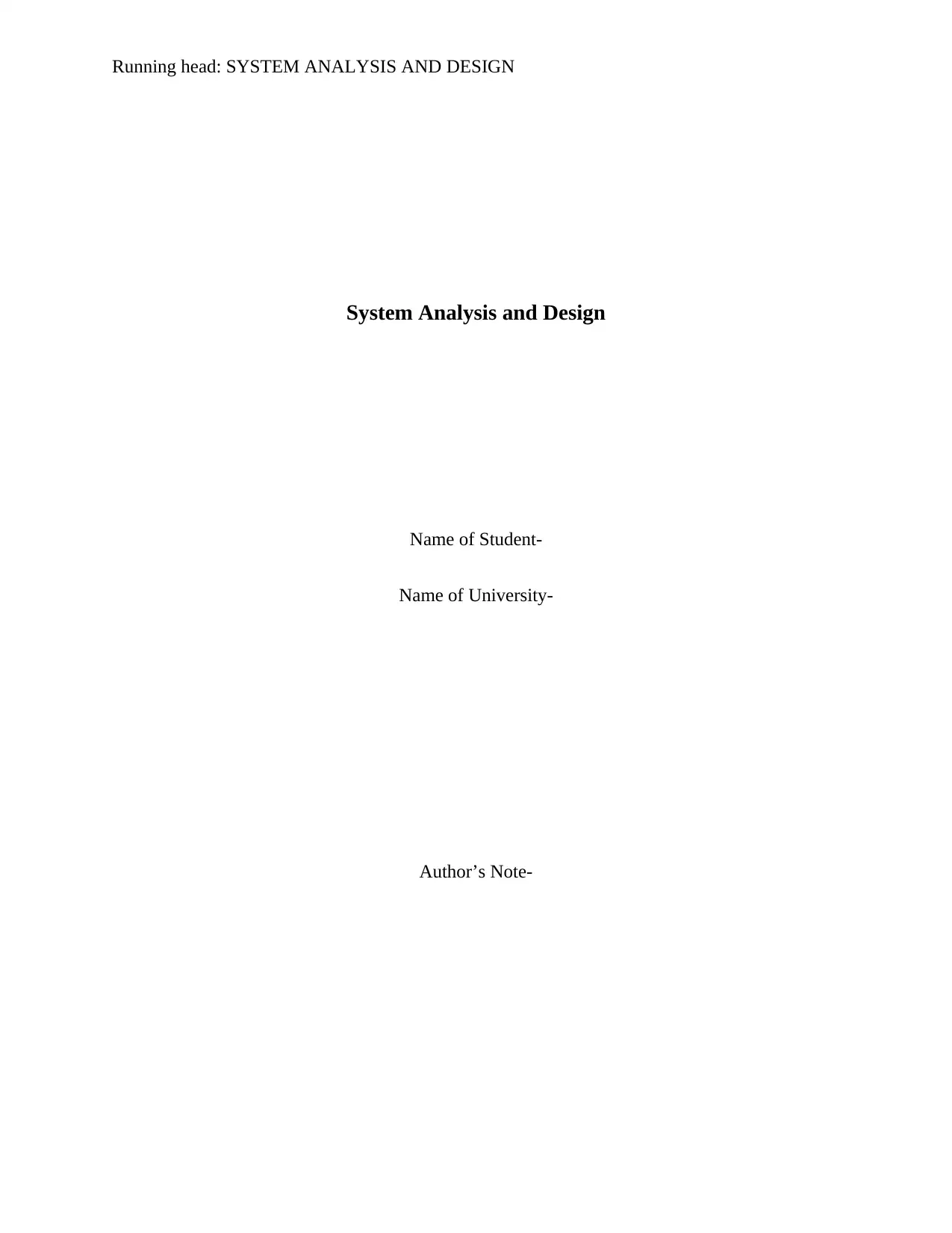
Running head: SYSTEM ANALYSIS AND DESIGN
System Analysis and Design
Name of Student-
Name of University-
Author’s Note-
System Analysis and Design
Name of Student-
Name of University-
Author’s Note-
Paraphrase This Document
Need a fresh take? Get an instant paraphrase of this document with our AI Paraphraser
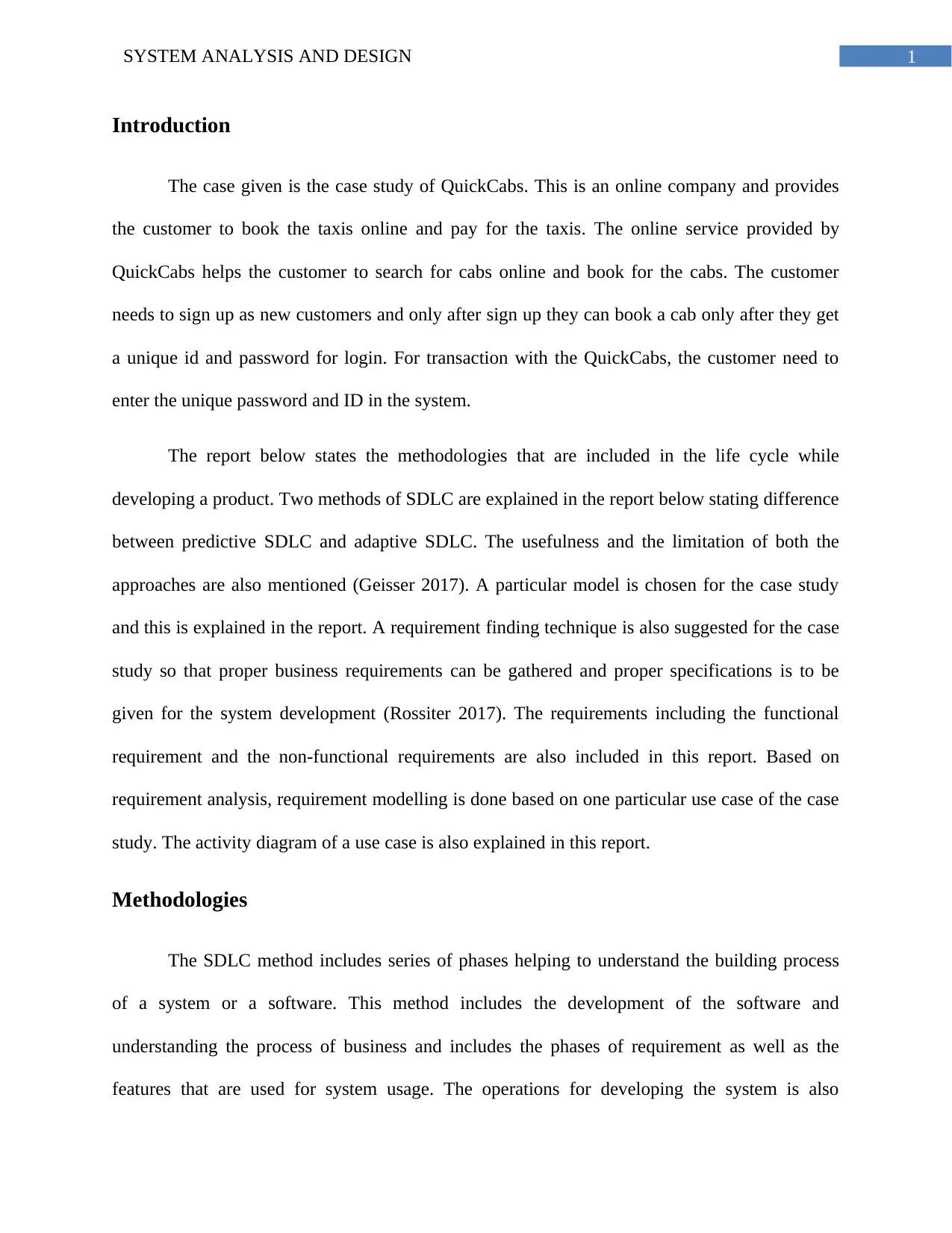
1SYSTEM ANALYSIS AND DESIGN
Introduction
The case given is the case study of QuickCabs. This is an online company and provides
the customer to book the taxis online and pay for the taxis. The online service provided by
QuickCabs helps the customer to search for cabs online and book for the cabs. The customer
needs to sign up as new customers and only after sign up they can book a cab only after they get
a unique id and password for login. For transaction with the QuickCabs, the customer need to
enter the unique password and ID in the system.
The report below states the methodologies that are included in the life cycle while
developing a product. Two methods of SDLC are explained in the report below stating difference
between predictive SDLC and adaptive SDLC. The usefulness and the limitation of both the
approaches are also mentioned (Geisser 2017). A particular model is chosen for the case study
and this is explained in the report. A requirement finding technique is also suggested for the case
study so that proper business requirements can be gathered and proper specifications is to be
given for the system development (Rossiter 2017). The requirements including the functional
requirement and the non-functional requirements are also included in this report. Based on
requirement analysis, requirement modelling is done based on one particular use case of the case
study. The activity diagram of a use case is also explained in this report.
Methodologies
The SDLC method includes series of phases helping to understand the building process
of a system or a software. This method includes the development of the software and
understanding the process of business and includes the phases of requirement as well as the
features that are used for system usage. The operations for developing the system is also
Introduction
The case given is the case study of QuickCabs. This is an online company and provides
the customer to book the taxis online and pay for the taxis. The online service provided by
QuickCabs helps the customer to search for cabs online and book for the cabs. The customer
needs to sign up as new customers and only after sign up they can book a cab only after they get
a unique id and password for login. For transaction with the QuickCabs, the customer need to
enter the unique password and ID in the system.
The report below states the methodologies that are included in the life cycle while
developing a product. Two methods of SDLC are explained in the report below stating difference
between predictive SDLC and adaptive SDLC. The usefulness and the limitation of both the
approaches are also mentioned (Geisser 2017). A particular model is chosen for the case study
and this is explained in the report. A requirement finding technique is also suggested for the case
study so that proper business requirements can be gathered and proper specifications is to be
given for the system development (Rossiter 2017). The requirements including the functional
requirement and the non-functional requirements are also included in this report. Based on
requirement analysis, requirement modelling is done based on one particular use case of the case
study. The activity diagram of a use case is also explained in this report.
Methodologies
The SDLC method includes series of phases helping to understand the building process
of a system or a software. This method includes the development of the software and
understanding the process of business and includes the phases of requirement as well as the
features that are used for system usage. The operations for developing the system is also
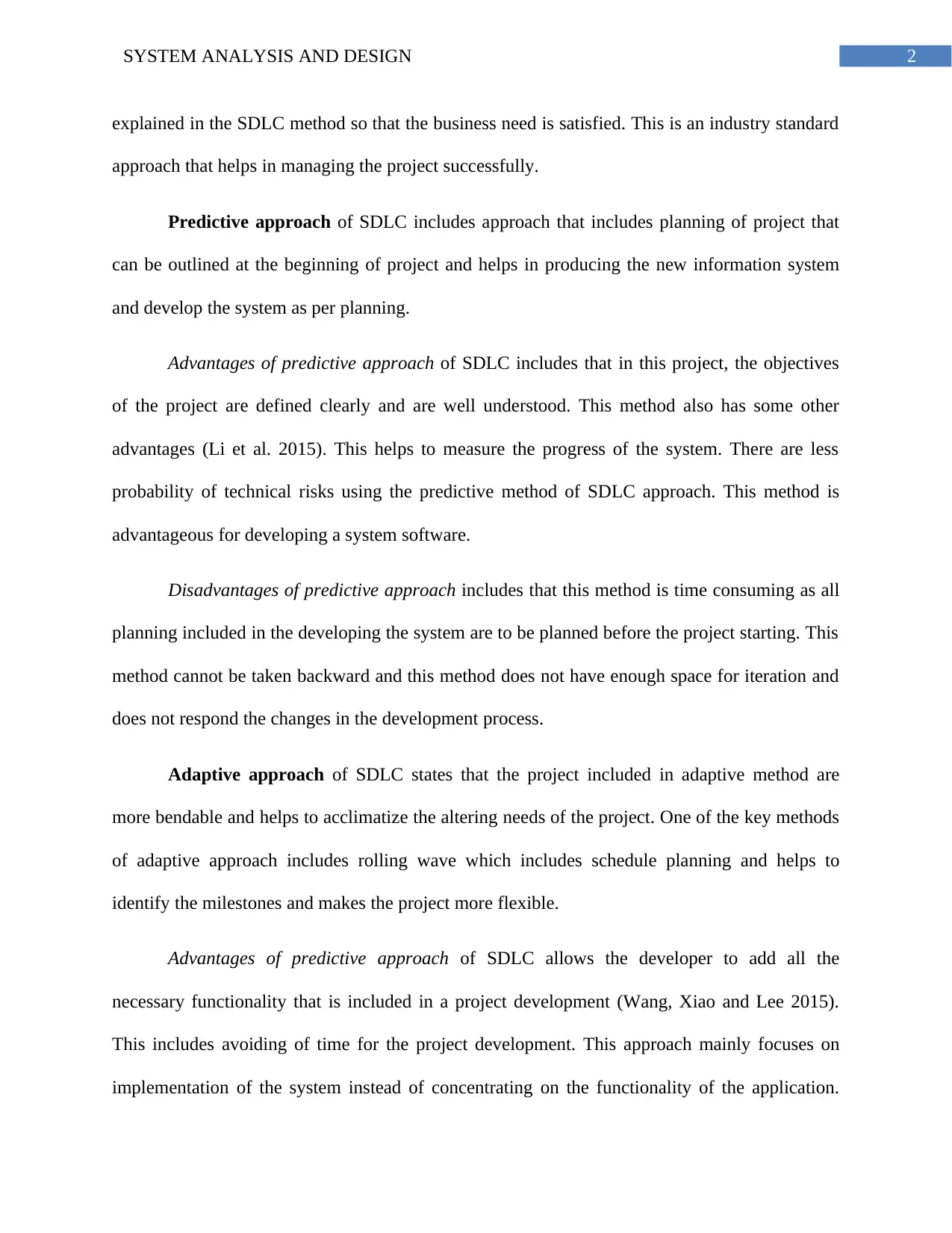
2SYSTEM ANALYSIS AND DESIGN
explained in the SDLC method so that the business need is satisfied. This is an industry standard
approach that helps in managing the project successfully.
Predictive approach of SDLC includes approach that includes planning of project that
can be outlined at the beginning of project and helps in producing the new information system
and develop the system as per planning.
Advantages of predictive approach of SDLC includes that in this project, the objectives
of the project are defined clearly and are well understood. This method also has some other
advantages (Li et al. 2015). This helps to measure the progress of the system. There are less
probability of technical risks using the predictive method of SDLC approach. This method is
advantageous for developing a system software.
Disadvantages of predictive approach includes that this method is time consuming as all
planning included in the developing the system are to be planned before the project starting. This
method cannot be taken backward and this method does not have enough space for iteration and
does not respond the changes in the development process.
Adaptive approach of SDLC states that the project included in adaptive method are
more bendable and helps to acclimatize the altering needs of the project. One of the key methods
of adaptive approach includes rolling wave which includes schedule planning and helps to
identify the milestones and makes the project more flexible.
Advantages of predictive approach of SDLC allows the developer to add all the
necessary functionality that is included in a project development (Wang, Xiao and Lee 2015).
This includes avoiding of time for the project development. This approach mainly focuses on
implementation of the system instead of concentrating on the functionality of the application.
explained in the SDLC method so that the business need is satisfied. This is an industry standard
approach that helps in managing the project successfully.
Predictive approach of SDLC includes approach that includes planning of project that
can be outlined at the beginning of project and helps in producing the new information system
and develop the system as per planning.
Advantages of predictive approach of SDLC includes that in this project, the objectives
of the project are defined clearly and are well understood. This method also has some other
advantages (Li et al. 2015). This helps to measure the progress of the system. There are less
probability of technical risks using the predictive method of SDLC approach. This method is
advantageous for developing a system software.
Disadvantages of predictive approach includes that this method is time consuming as all
planning included in the developing the system are to be planned before the project starting. This
method cannot be taken backward and this method does not have enough space for iteration and
does not respond the changes in the development process.
Adaptive approach of SDLC states that the project included in adaptive method are
more bendable and helps to acclimatize the altering needs of the project. One of the key methods
of adaptive approach includes rolling wave which includes schedule planning and helps to
identify the milestones and makes the project more flexible.
Advantages of predictive approach of SDLC allows the developer to add all the
necessary functionality that is included in a project development (Wang, Xiao and Lee 2015).
This includes avoiding of time for the project development. This approach mainly focuses on
implementation of the system instead of concentrating on the functionality of the application.
⊘ This is a preview!⊘
Do you want full access?
Subscribe today to unlock all pages.

Trusted by 1+ million students worldwide
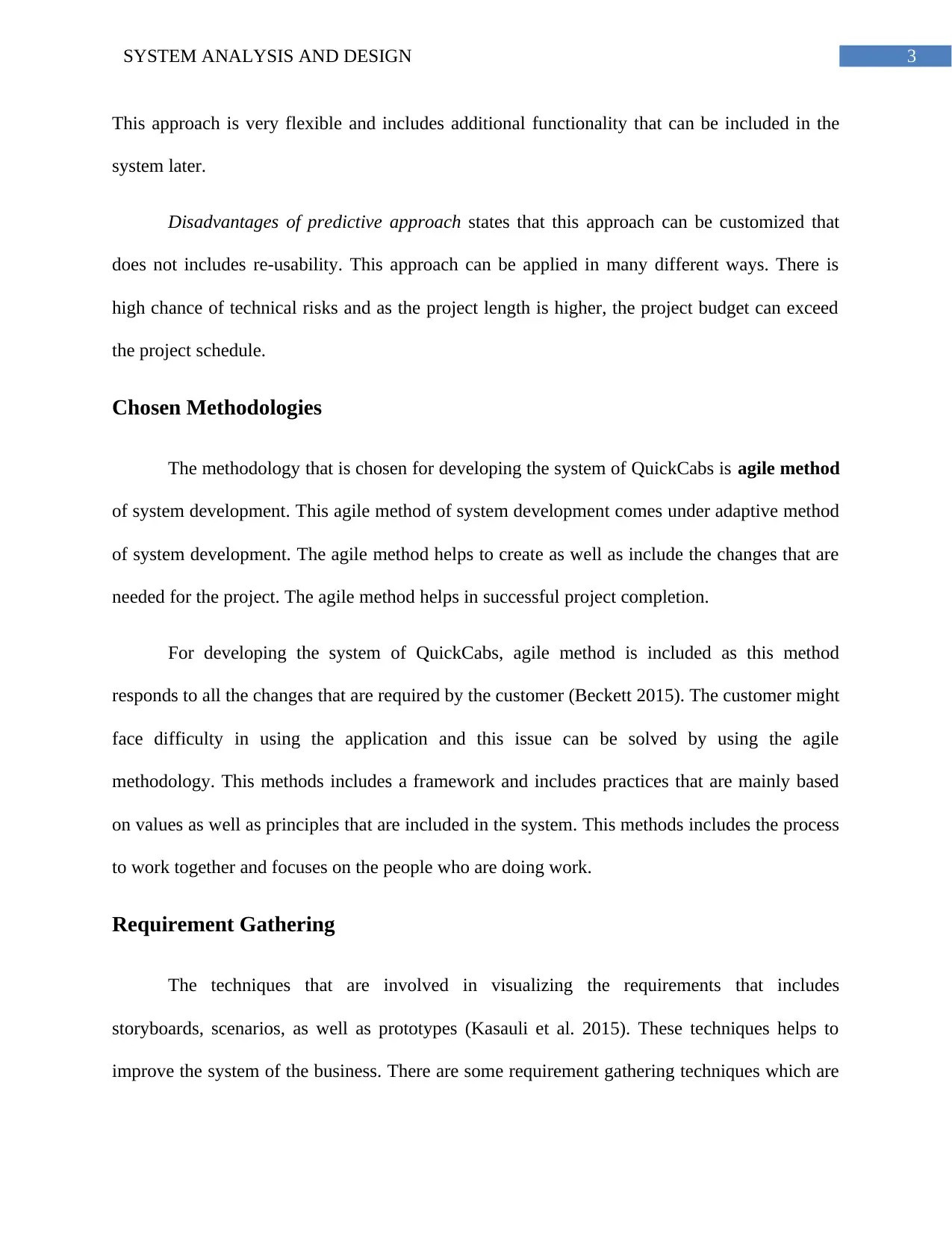
3SYSTEM ANALYSIS AND DESIGN
This approach is very flexible and includes additional functionality that can be included in the
system later.
Disadvantages of predictive approach states that this approach can be customized that
does not includes re-usability. This approach can be applied in many different ways. There is
high chance of technical risks and as the project length is higher, the project budget can exceed
the project schedule.
Chosen Methodologies
The methodology that is chosen for developing the system of QuickCabs is agile method
of system development. This agile method of system development comes under adaptive method
of system development. The agile method helps to create as well as include the changes that are
needed for the project. The agile method helps in successful project completion.
For developing the system of QuickCabs, agile method is included as this method
responds to all the changes that are required by the customer (Beckett 2015). The customer might
face difficulty in using the application and this issue can be solved by using the agile
methodology. This methods includes a framework and includes practices that are mainly based
on values as well as principles that are included in the system. This methods includes the process
to work together and focuses on the people who are doing work.
Requirement Gathering
The techniques that are involved in visualizing the requirements that includes
storyboards, scenarios, as well as prototypes (Kasauli et al. 2015). These techniques helps to
improve the system of the business. There are some requirement gathering techniques which are
This approach is very flexible and includes additional functionality that can be included in the
system later.
Disadvantages of predictive approach states that this approach can be customized that
does not includes re-usability. This approach can be applied in many different ways. There is
high chance of technical risks and as the project length is higher, the project budget can exceed
the project schedule.
Chosen Methodologies
The methodology that is chosen for developing the system of QuickCabs is agile method
of system development. This agile method of system development comes under adaptive method
of system development. The agile method helps to create as well as include the changes that are
needed for the project. The agile method helps in successful project completion.
For developing the system of QuickCabs, agile method is included as this method
responds to all the changes that are required by the customer (Beckett 2015). The customer might
face difficulty in using the application and this issue can be solved by using the agile
methodology. This methods includes a framework and includes practices that are mainly based
on values as well as principles that are included in the system. This methods includes the process
to work together and focuses on the people who are doing work.
Requirement Gathering
The techniques that are involved in visualizing the requirements that includes
storyboards, scenarios, as well as prototypes (Kasauli et al. 2015). These techniques helps to
improve the system of the business. There are some requirement gathering techniques which are
Paraphrase This Document
Need a fresh take? Get an instant paraphrase of this document with our AI Paraphraser
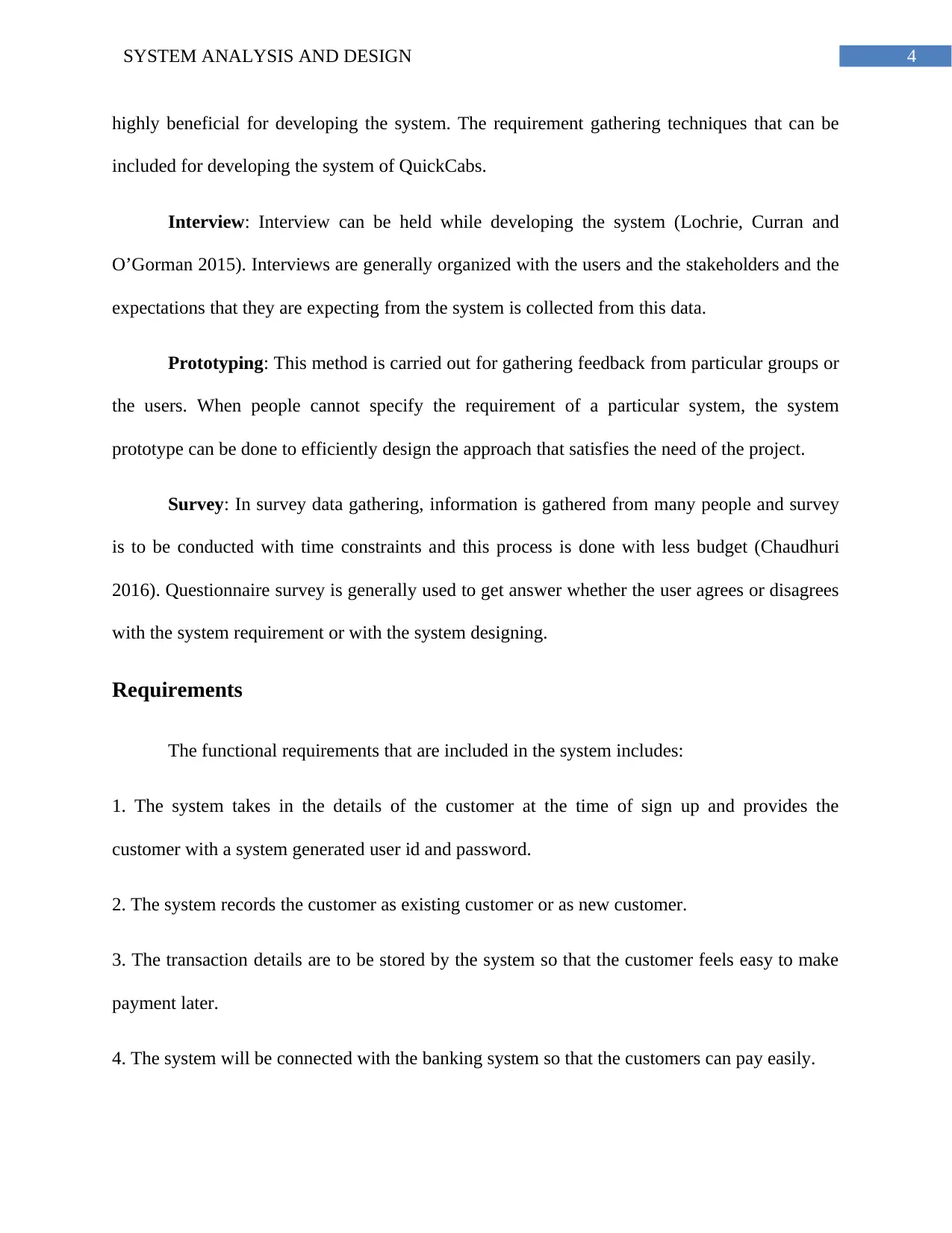
4SYSTEM ANALYSIS AND DESIGN
highly beneficial for developing the system. The requirement gathering techniques that can be
included for developing the system of QuickCabs.
Interview: Interview can be held while developing the system (Lochrie, Curran and
O’Gorman 2015). Interviews are generally organized with the users and the stakeholders and the
expectations that they are expecting from the system is collected from this data.
Prototyping: This method is carried out for gathering feedback from particular groups or
the users. When people cannot specify the requirement of a particular system, the system
prototype can be done to efficiently design the approach that satisfies the need of the project.
Survey: In survey data gathering, information is gathered from many people and survey
is to be conducted with time constraints and this process is done with less budget (Chaudhuri
2016). Questionnaire survey is generally used to get answer whether the user agrees or disagrees
with the system requirement or with the system designing.
Requirements
The functional requirements that are included in the system includes:
1. The system takes in the details of the customer at the time of sign up and provides the
customer with a system generated user id and password.
2. The system records the customer as existing customer or as new customer.
3. The transaction details are to be stored by the system so that the customer feels easy to make
payment later.
4. The system will be connected with the banking system so that the customers can pay easily.
highly beneficial for developing the system. The requirement gathering techniques that can be
included for developing the system of QuickCabs.
Interview: Interview can be held while developing the system (Lochrie, Curran and
O’Gorman 2015). Interviews are generally organized with the users and the stakeholders and the
expectations that they are expecting from the system is collected from this data.
Prototyping: This method is carried out for gathering feedback from particular groups or
the users. When people cannot specify the requirement of a particular system, the system
prototype can be done to efficiently design the approach that satisfies the need of the project.
Survey: In survey data gathering, information is gathered from many people and survey
is to be conducted with time constraints and this process is done with less budget (Chaudhuri
2016). Questionnaire survey is generally used to get answer whether the user agrees or disagrees
with the system requirement or with the system designing.
Requirements
The functional requirements that are included in the system includes:
1. The system takes in the details of the customer at the time of sign up and provides the
customer with a system generated user id and password.
2. The system records the customer as existing customer or as new customer.
3. The transaction details are to be stored by the system so that the customer feels easy to make
payment later.
4. The system will be connected with the banking system so that the customers can pay easily.
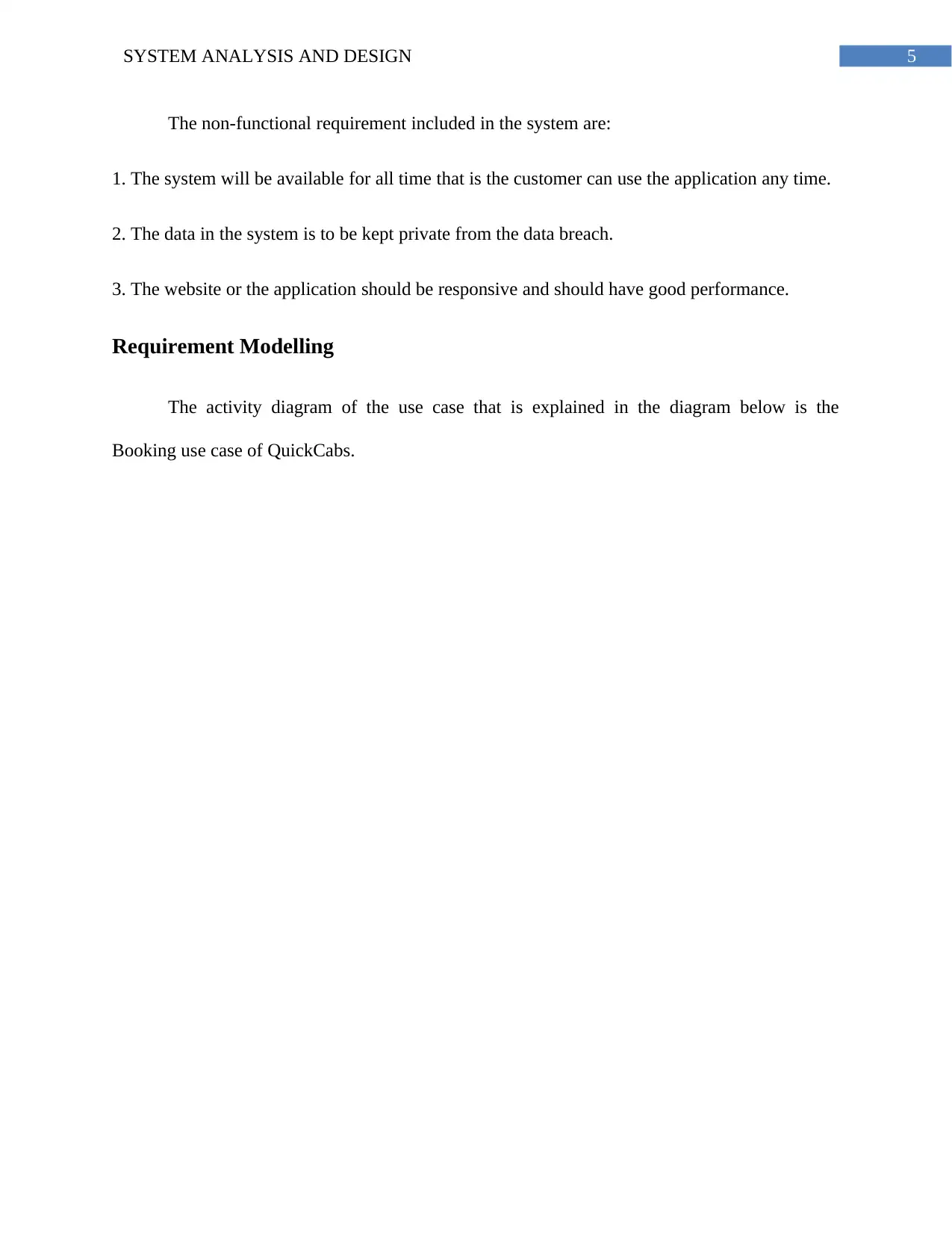
5SYSTEM ANALYSIS AND DESIGN
The non-functional requirement included in the system are:
1. The system will be available for all time that is the customer can use the application any time.
2. The data in the system is to be kept private from the data breach.
3. The website or the application should be responsive and should have good performance.
Requirement Modelling
The activity diagram of the use case that is explained in the diagram below is the
Booking use case of QuickCabs.
The non-functional requirement included in the system are:
1. The system will be available for all time that is the customer can use the application any time.
2. The data in the system is to be kept private from the data breach.
3. The website or the application should be responsive and should have good performance.
Requirement Modelling
The activity diagram of the use case that is explained in the diagram below is the
Booking use case of QuickCabs.
⊘ This is a preview!⊘
Do you want full access?
Subscribe today to unlock all pages.

Trusted by 1+ million students worldwide
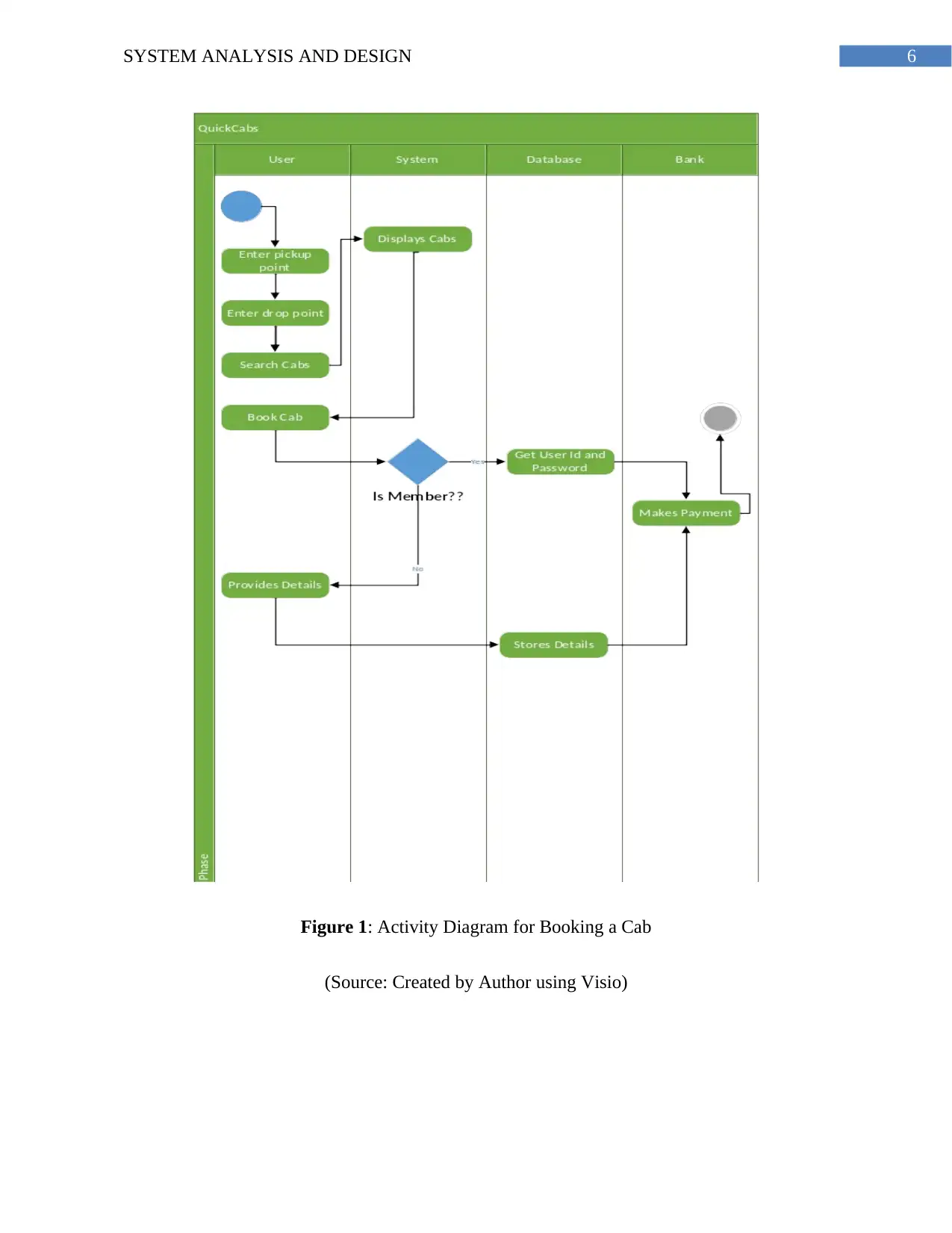
6SYSTEM ANALYSIS AND DESIGN
Figure 1: Activity Diagram for Booking a Cab
(Source: Created by Author using Visio)
Figure 1: Activity Diagram for Booking a Cab
(Source: Created by Author using Visio)
Paraphrase This Document
Need a fresh take? Get an instant paraphrase of this document with our AI Paraphraser
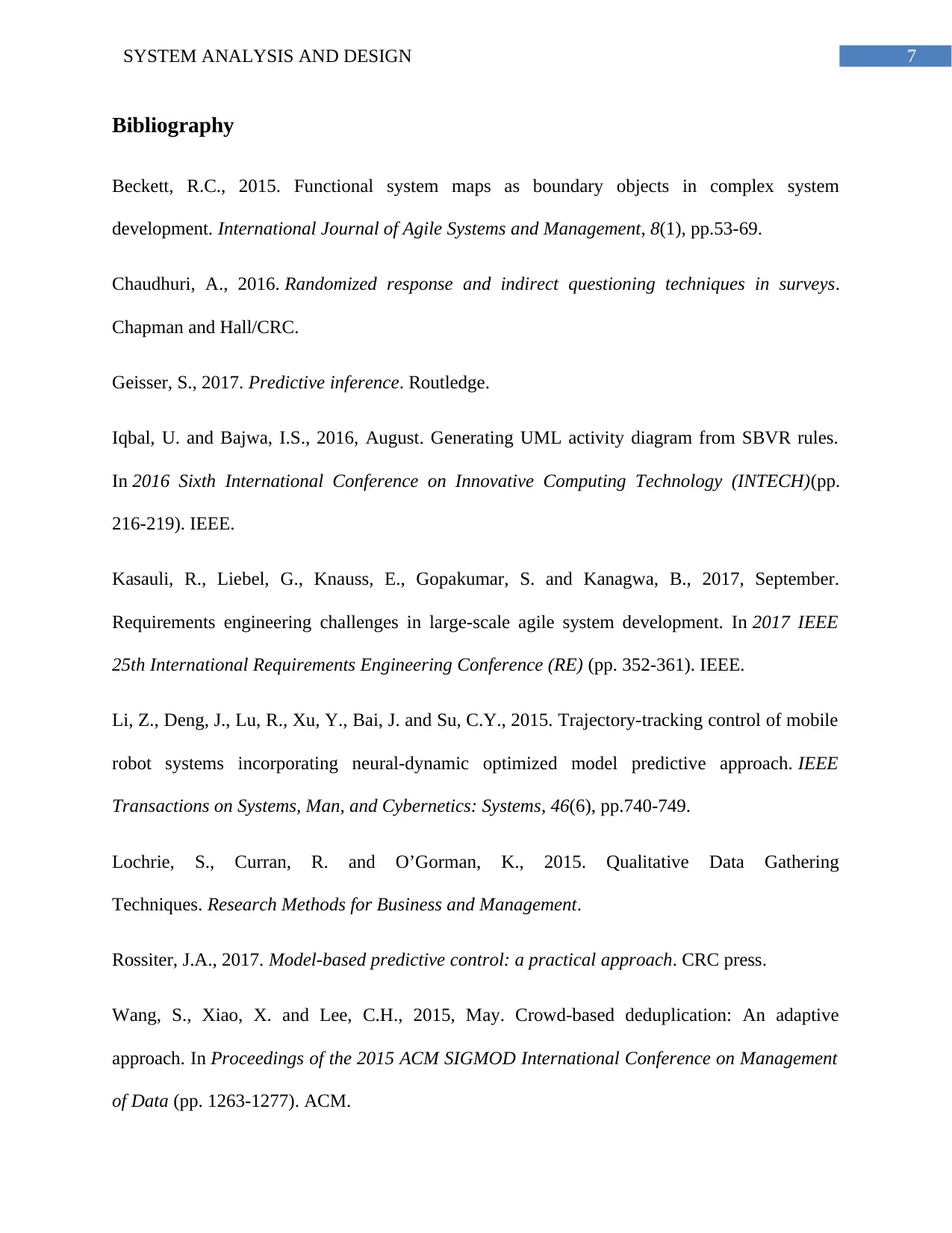
7SYSTEM ANALYSIS AND DESIGN
Bibliography
Beckett, R.C., 2015. Functional system maps as boundary objects in complex system
development. International Journal of Agile Systems and Management, 8(1), pp.53-69.
Chaudhuri, A., 2016. Randomized response and indirect questioning techniques in surveys.
Chapman and Hall/CRC.
Geisser, S., 2017. Predictive inference. Routledge.
Iqbal, U. and Bajwa, I.S., 2016, August. Generating UML activity diagram from SBVR rules.
In 2016 Sixth International Conference on Innovative Computing Technology (INTECH)(pp.
216-219). IEEE.
Kasauli, R., Liebel, G., Knauss, E., Gopakumar, S. and Kanagwa, B., 2017, September.
Requirements engineering challenges in large-scale agile system development. In 2017 IEEE
25th International Requirements Engineering Conference (RE) (pp. 352-361). IEEE.
Li, Z., Deng, J., Lu, R., Xu, Y., Bai, J. and Su, C.Y., 2015. Trajectory-tracking control of mobile
robot systems incorporating neural-dynamic optimized model predictive approach. IEEE
Transactions on Systems, Man, and Cybernetics: Systems, 46(6), pp.740-749.
Lochrie, S., Curran, R. and O’Gorman, K., 2015. Qualitative Data Gathering
Techniques. Research Methods for Business and Management.
Rossiter, J.A., 2017. Model-based predictive control: a practical approach. CRC press.
Wang, S., Xiao, X. and Lee, C.H., 2015, May. Crowd-based deduplication: An adaptive
approach. In Proceedings of the 2015 ACM SIGMOD International Conference on Management
of Data (pp. 1263-1277). ACM.
Bibliography
Beckett, R.C., 2015. Functional system maps as boundary objects in complex system
development. International Journal of Agile Systems and Management, 8(1), pp.53-69.
Chaudhuri, A., 2016. Randomized response and indirect questioning techniques in surveys.
Chapman and Hall/CRC.
Geisser, S., 2017. Predictive inference. Routledge.
Iqbal, U. and Bajwa, I.S., 2016, August. Generating UML activity diagram from SBVR rules.
In 2016 Sixth International Conference on Innovative Computing Technology (INTECH)(pp.
216-219). IEEE.
Kasauli, R., Liebel, G., Knauss, E., Gopakumar, S. and Kanagwa, B., 2017, September.
Requirements engineering challenges in large-scale agile system development. In 2017 IEEE
25th International Requirements Engineering Conference (RE) (pp. 352-361). IEEE.
Li, Z., Deng, J., Lu, R., Xu, Y., Bai, J. and Su, C.Y., 2015. Trajectory-tracking control of mobile
robot systems incorporating neural-dynamic optimized model predictive approach. IEEE
Transactions on Systems, Man, and Cybernetics: Systems, 46(6), pp.740-749.
Lochrie, S., Curran, R. and O’Gorman, K., 2015. Qualitative Data Gathering
Techniques. Research Methods for Business and Management.
Rossiter, J.A., 2017. Model-based predictive control: a practical approach. CRC press.
Wang, S., Xiao, X. and Lee, C.H., 2015, May. Crowd-based deduplication: An adaptive
approach. In Proceedings of the 2015 ACM SIGMOD International Conference on Management
of Data (pp. 1263-1277). ACM.
1 out of 8
Related Documents
Your All-in-One AI-Powered Toolkit for Academic Success.
+13062052269
info@desklib.com
Available 24*7 on WhatsApp / Email
![[object Object]](/_next/static/media/star-bottom.7253800d.svg)
Unlock your academic potential
Copyright © 2020–2025 A2Z Services. All Rights Reserved. Developed and managed by ZUCOL.





